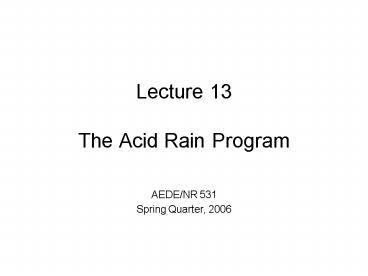Lecture 13 The Acid Rain Program - PowerPoint PPT Presentation
1 / 20
Title:
Lecture 13 The Acid Rain Program
Description:
Acid rain caused consideration environmental damage to areas downwind from these ... Acid Rain Program Goals. Reduce sulfur emissions by 10 million tons below ... – PowerPoint PPT presentation
Number of Views:163
Avg rating:3.0/5.0
Title: Lecture 13 The Acid Rain Program
1
Lecture 13The Acid Rain Program
- AEDE/NR 531
- Spring Quarter, 2006
2
Air A Public Good
- In the last 50 years, it became clear that
electricity plants produced sulfur dioxide which
resulted in acid rain. - Acid rain caused consideration environmental
damage to areas downwind from these plants, often
hundreds or thousands of miles away. - It was a difficult problem to address because
clean air is a public good. - Even if property rights over the air were given
to the electricity company or to those living in
affected areas, bargaining likely would not have
taken place because of the public good problem.
3
Acid Rain
- 70 of all fossil fuel combustion in the U.S. is
for electricity production. - To circumvent the public good problem, government
intervention is a likely option. - Options The government could have restricted all
power plants to a set sulfur emission level.
This would have ignored the fact that some plants
could have reduced sulfur emissions at lower cost
than others. - Why do different plants have different abatement
cost curves?
4
Acid Rain Program Goals
- Reduce sulfur emissions by 10 million tons below
1980 levels. - Used a two-phased tightening of restrictions
schedule. - Phase I
- Phase II
5
Acid Rain Program
- Is often called a Cap and Trade program.
- Utilities were allocated allowances based on
their historic fuel consumption and specific
emission rate. Units built after 1996 are not
allocated allowances. - An allowance allows a utility to produce 1 ton of
SO2 during a year. - For each ton of SO2 produced, an allowance is
retired for that year. - Allowances can be bought, sold, or banked. Phase
II capped total allowances at 8.95 million. - Anyone can participate in the market.
6
When to Use a Trading Based Policy
- Some environmental problems are more difficult to
address through an incentive based trading
program. - Characteristics that make an environmental
problem attractive for a trading based incentive
program
7
How Can Utilities Meet Allowances
8
Fuel Sources for Electricity Production
9
Allowance Auctions
- Allowance auction for a small portion (2.8) of
the total set of allowances is held annually.
They help send the market a signal of the price
of an allowance. - Auctions were run by the Chicago Board of Trade.
- Sealed bid auction were bidders send sealed offer
in. - Allowances are then sold starting with the
highest bids until no allowances remain.
10
Allowance Auction 2006
- 125,000 allowances supplied by the EPA.
- Winning bidders included Morgan Stanley, JP
Morgan, Grey K Environmental, Suez Energy
Marketing, Acid Rain Retirement Fund, Clean Air
Conservancy Charitable Trust, among others. - Highest bid 1700
- Clearing bid (lowest bid that was awarded
allowances) 860.07. - Lowest bid 650
11
Allowance Auctions
12
Allowance Trading
13
Allowance Trading
14
Allowance Trading
15
Allowance Trading
- Why has the price of allowance permits gone up
recently?
16
Compliance and Enforcement
- EPA runs the Allowance Tracking System.
- EPA is notified by allow units of transferring
allowances from one unit to another. - Continuous Emissions Monitoring System is used
that employs electronic sensor systems in smoke
stacks in all units. - If a unit emits more than its allowance, it must
pay 2525 per excess ton of sulfur dioxide. It
must also surrender allowances for the following
year to EPA as excess emissions offsets.
17
Results
- Despite a 20 increase in utilization, SO2
emissions decreased 13 from 1995 to 2004. - General Accounting Office estimates that as much
as 3 Billion per year is saved using the Acid
Rain Training Program compared to a Command and
Control approach. - When accounting for prevented damage to the
environment and human health, estimated annual
benefits of the sulfur trading program in 2010
are 122 Billion.
18
Results
19
Results
20
Summary Document
- http//www.epa.gov/airmarkets/cmprpt/arp04/2004rep
ort.pdf































